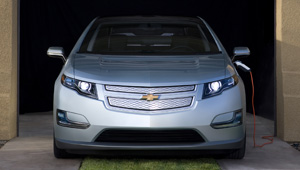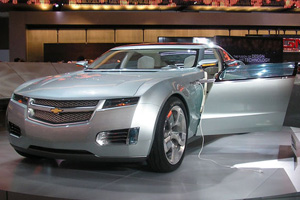
GM Corp
I’m about as far from a gearhead as it gets, but even so, I was excited about the release of the nation’s first two consumer plug-in electric vehicles: the Chevy Volt and the Nissan Leaf. The Volt can go 40 miles on battery power and another 310 thanks to an auxiliary gas engine, which kicked in smoothly as I floored it up a hill during a recent test drive. The Leaf is—even cooler—completely electric, with a range of about 100 miles. In 2011, Ford, Mitsubishi, and Mercedes-Benz plan to introduce their own tailpipe-free models. GE has ordered up thousands for its sales force, and the federal government has set a target for 1 million electric vehicles by 2015. (A good step, even considering the 246 million or so gas vehicles already on the road.) Are we finally ready after years of false starts? Despite widespread public jitters, the experts I polled said yes. Herewith, eight e-car worries not to spin your wheels over.
- Our grid can’t handle the added burden. While electric cars do use a great deal of juice, utilities have been working behind the scenes for years to make sure the cars don’t fry the grid. Blackouts are “extremely unlikely,” notes Simon Mui, a scientist who studies clean vehicles and fuels for the Natural Resources Defense Council (NRDC). Advanced charging technology will help distribute power loads more evenly, and many home charging stations will operate only during off-peak hours—which is more efficient and usually cheaper. “Smart chargers,” slated to hit the market in 2011, will decide when to charge based on the time and distance you commute, local rates, and electricity demand in your neighborhood.
- My utility bill will skyrocket. Yep, you’ll spend more on amperage, but your savings on gas will more than cover it. If you drive a battery-only car 12,000 miles a year at going power rates, you’ll pay an extra $27 or so per month for electricity, but save about $97 on gas. Some utilities offer special rates during off-peak hours—in California, you might pay as little as $13 a month (roughly half-price) to charge up at night. The one drawback of cheaper fuel is, well, cheaper driving, which some experts worry will lure commuters away from public transit, carpools, and bikes.
- Coal-burning utilities mean electric cars will make emissions worse. Hardly. Even in predominantly coal-burning regions, an electric car releases 35 to 60 percent less CO2 than a comparable conventional car, according to industry think tank Electric Power Research Institute (EPRI). In areas with an ecofriendly power mix, the emissions are up to 75 percent lower. EPRI transportation expert Mark Duvall points out that “as the grid gets cleaner—which it almost certainly will—electric cars will get cleaner, too.” Bonus: Unlike gas, which is refined largely from imported petroleum, electricity flows from domestic sources.
- Electric cars already flopped once, so why should I believe they’ll succeed? Climate worries, obviously, have gained traction since the 1990s, but the main reason to believe in a comeback is economic. Perhaps you’ve noticed that Detroit seems, uh, a little leaner than it was during the Clinton years. To compete with foreign automakers in places with high gas prices and tougher climate regs—think Europe and California—the industry needs to roll out efficient models. “Automakers see this as a necessity,” says Mui. Technology has really improved, too; old-school e-car batteries, famous for exploding and generally sucking, have joined your wallet chains and Crash Test Dummies albums in ’90s heaven.
- Government rebates on electric cars favor the rich. To ease sticker shock (the Volt starts at $40,280; the Leaf, $32,780), the feds are offering a tax credit of up to $7,500 to the first 200,000 buyers of each model. If you still can’t afford one, there’s a consolation prize: As Mui points out, the reductions in emissions and pollution will benefit everyone. Plus, prices are sure to come down. The very first iPods, you may recall, set you back more than $400.
- Electric cars handle like roller skates. I’m not the savviest driver, but I thought the Volt felt pretty much like a regular mid-size. Car and Driver writes that it “drives surprisingly well, with a reassuringly steady suspension.” The Leaf gets dinged for its short range, but its transmission works so smoothly in stop-and-go traffic “that we started rationalizing our range concerns.”
- Lithium-ion auto batteries are as crappy as lithium-ion laptop batteries. Now here’s something that might be worth fretting about. Although battery technology is light-years beyond where it was back when GM was peddling EV1s, it’s far from perfect. Lithium-ion cells are sluggish in cold weather—and cranking the heat, AC, or stereo will reduce your range. More worrisome: No one can predict how long they’ll last. “There will be degradation of the battery over its lifetime,” says EPRI’s Duvall. “But we don’t know exactly how much.” The good news: Recent breakthroughs in battery technology promise faster charging and greater reliability. In the meantime, both Volt and Leaf come with eight-year battery warranties.
- I’ll run out of juice in the sticks. This is only an issue for fully electric cars, and as long as you’re within range of a socket, you’ll make do. A full charge takes about 10 hours using a standard outlet, or half as long with a home 220-volt station that’ll run you about $2,000. Meanwhile, the federal government plans to spend $115 million to help cities set up 15,000 pay-as-you-go chargers in public places. Electric vehicles “do require a lot of planning, but not as much as you might think,” says Mark Vaughn, an AutoWeek editor who blogged last summer about his trial run with Mitsubishi’s i MiEV—comparable to the Leaf. When Vaughn showed up at a hotel with a low battery, he told me, a kitchen employee offered to snake an extension cord out to the parking lot. “You really learn as much about people as you do about amps and volts and things like that.”
BANG FOR YOUR VOLT
How gas, hybrid, and plug-in cars stack up.
|
MODEL |
TYPE |
STARTS AT* |
RANGE IN MILES |
CO2 EMITTED (100 MILES) |
COST OF FUEL FOR 60K MILES |
|
Honda Civic |
Conventional |
$15,805 |
200 |
87 lbs. |
$5,000 |
|
Toyota Prius |
Gas-electric hybrid |
$22,800 |
600 |
51 lbs. |
$3,600 |
|
Chevy Volt |
Electric with gas backup engine |
$32,780* |
350** |
51 lbs. |
$2,370*** |
|
Nissan Leaf |
Pure electric |
$25,280* |
100 |
37 lbs. |
$1,615 |
|
*After tax rebate **40 miles on electricity alone ***Assumes a 62/38 electricity-to-gas fuel ratio |
|||||
Got a burning eco-quandary? Submit it to econundrums@motherjones.com. Get all your green questions answered by visiting Econundrums on Facebook here.











